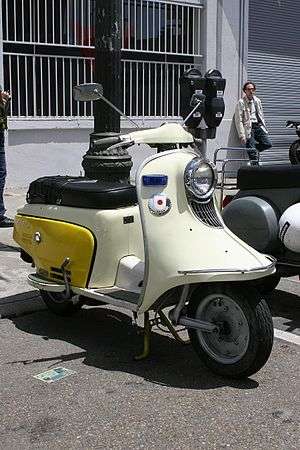Fuji Rabbit
 Fuji Touring 150 - side view | |
| Manufacturer |
Fuji-Sangyo now Fuji Heavy Industries, Ltd.[1] |
|---|---|
| Also called | Fuji Rabbit scooter |
| Production | 1946— |
| Predecessor | Powell Streamliner [2] |
| Class | Scooter |
| Engine |
135 cm3 (8.2 cu in) 4-stroke, SV air-cooled, vertical single-cylinder [2] |
| Bore / stroke | 55 mm × 57 mm (2.2 in × 2.2 in) [2] |
| Power | 2 PS (1.5 kW; 2.0 hp) at 3000 rpm [2] |
| Frame type | Ladder tube [2] |
| Wheelbase | 1,115 mm (43.9 in) [2] |
| Dimensions |
L: 1,547 mm (60.9 in) W: 545 mm (21.5 in) H: 940 mm (37 in) [2] |
| Weight |
75 kg (165 lb) [2] (dry) |
| Fuel capacity | 5.6 L (1.2 imp gal; 1.5 US gal) [2] |
| Fuel consumption | 35 km/L (99 mpg-imp; 82 mpg-US) [2] |
The Fuji Rabbit is a motor scooter produced in Japan by Fuji Heavy Industries from 1946 through 1968. The Society of Automotive Engineers of Japan (Japanese) rates the Fuji Rabbit S-1 model introduced in 1946 as one of their 240 Landmarks of Japanese Automotive Technology.[2]
Production

.jpg)
Production of the initial model, the S-1 began in 1946, some six months before the Vespa went into production[3] and was largely inspired by scooters used by American servicemen during and after World War II. As the first motor scooter manufactured in Japan, it was enormously successful and revolutionized the post-war vehicle industry.[2] Eventually the Fuji Rabbit scooters evolved into some of the most technologically sophisticated scooters of their era, featuring electric starters, automatic transmissions and pneumatic suspension systems. The Fuji Rabbit scooters were the first Japanese made scooters capable of reaching speeds in excess of 60 miles per hour (97 km/h). The Rabbit's primary competitor was the Mitsubishi Silver Pigeon, which also started production around the same time as the Rabbit. Motor scooters were so important to the post-war vehicle industry that In May 1948 both a Silver Pigeon and a Rabbit were presented to the Emperor of Japan.[1] Starting in 1954 the Rabbit also faced competition from the Honda Juno.
As the Japanese economy expanded, the demand for scooters decreased in favor of more comfortable four wheel transport, and Fuji diversified into automobiles in 1958 with the introduction of the Subaru 360. The last Fuji scooter rolled off the production line in June 1968.
Featured in films
Although not very well known outside Japan, the Fuji Rabbit has earned itself a place in Japanese pop culture as a symbol of nostalgia. Fuji Rabbits have been featured in Japanese animated series such as FLCL and Paranoia Agent and are a favourite amongst collectors of scooters and motorcycles in Japan.
North America
In North America, the Fuji Rabbit is best known for starting Malcolm Bricklin's motor vehicle career. (Bricklin was later responsible for importing the Subaru 360 and the Yugo hatchback, as well as producing his own car, among other things). The main importer for North America was the American Rabbit Corporation.
References
- 1 2 "Silver Pigeon (Motor Scooter)". 240 Landmarks of Japanese Automotive Technology. Society of Automotive Engineers of Japan, Inc. Retrieved 12 August 2013.
The Silver Pigeon and the Rabbit motor scooter manufactured by Fuji-Sangyo (now Fuji Heavy Industries Inc.) dominated the vehicle industry, and both became convenient means of transportation for ordinary people, who had lacked adequate transportation.
- 1 2 3 4 5 6 7 8 9 10 11 12 "Rabbit Motor Scooter". 240 Landmarks of Japanese Automotive Technology. Society of Automotive Engineers of Japan, Inc. Retrieved 11 August 2013.
This scooter was manufactured right after World War II, using the U.S. Army airborne troops' Powell motor scooter as its model.
- ↑ "Fuji Rabbit Scooters History". Fujirabbit.com. Retrieved 2008-11-22.
| Wikimedia Commons has media related to Fuji Rabbit scooters. |